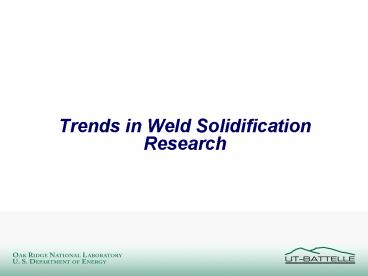Trends in Weld Solidification Research - PowerPoint PPT Presentation
1 / 15
Title:
Trends in Weld Solidification Research
Description:
The dendrite selection based on heat-flow was observed. ... weld region consists of three distinct dendrite-growth directions and 'stray' crystals. ... – PowerPoint PPT presentation
Number of Views:1000
Avg rating:5.0/5.0
Title: Trends in Weld Solidification Research
1
Trends in Weld Solidification Research
2
Weld pool solidification lies in between ingot
solidification and rapid solidification.
Increasing Growth Rate
Weld Pool Solidification
Ingot Solidification
Rapid Solidification
V101 ms-1
V10-4 ms-1
V102 ms-1
- Our current knowledge of weld pool solidification
is an extrapolation of the freezing of castings,
ingots, and single crystals at lower thermal
gradients and slower growth rates. - In recent years theories to understand weld pool
solidification have been developed.
3
Weld solidification microstructure is controlled
by temperature gradient (G) and crystal growth
rate (R).
- Weld pool shape, cooling rate and composition of
the weld affect the microstructure.
4
Variations in weld microstructures as a function
of temperature gradient (G), growth rate (R) and
combinations of these (G.R and G/R).
- Weld pool shape has profound effect
- No nucleation barrier.
- As in castings, solidification parameters namely
undercooling (?T), growth rate (R), Thermal
gradient (G) and alloy constitution influence
weld microstructures. - Scale of microstructural features are much finer.
5
Predicted breakdown from planar to non-planar
solidification growth front can be observed.
- Analytical Modeling and Experiments
- David and Vitek
- H. W. Kerr
- S. Kou
- Cellular Automata Model
- Rappaz et al. (Castings)
- Dress et al. (Weld Solidification)
6
Using metal analog system, we can observe the
evolution of solidification microstructure.
- The experiment was performed at different welding
speeds.
7
Results of the observed weld pool shapes in pure
succinonitrile
- Elongated weld pool shapes were observed.
8
Dendritic microstructure was observed in alloy
system.
- The dendrite selection based on heat-flow was
observed.
9
At higher cooling rate, instability along
liquid/solid interface was observed.
- This leads to excessive growth of certain
dendrites into the weld pool.
10
Using a geometrical analysis and expressing the
solidification front normal and the
crystallographic growth directions in terms of a
fixed set of reference axes, dendrite growth
selection process can be calculated.
(001) Surface - 100 weld
(110) Surface - 111 weld
- Future Work
- Growth Competition (Vitek, David and Boatner)
11
weld region consists of three distinct
dendrite-growth directions and stray crystals.
- This is due to epitaxial solidification from the
single-crystal base metal. - Stray crystals were associated with weld cracks.
12
Modeling solute redistribution must consider
undercooling due to capillarity.
Volume Element
Solid
Liquid
- Above equations are for conventional
solidification - Weld pool solidification (J. A. Brooks)
- Total dendrite tip undercooling is important.
- ?T ?Td(constitutional) ?T? (capillarity)
?Tk (kinetics) . - Convection effects on solute distribution also
needs to be considered.
13
Rapid solidification leads to nonequilibrium
solidification.
- Nonequilibrium solidification leads to
- Nonequilibrium partition coefficient, k.
- formation of nonequilibrium phases.
- changes in general microstructure.
14
It is possible to calculate the departure from
equilibrium partition coefficient using
theoretical equations.
- Extension of these equations to multicomponent
systems needs further work.
15
Tutorials
- Evaluate the partition coefficient as a function
of velocity for Fe-Ni-Cr-C-N alloy system during
solidification and assume different diffusion
coefficient for interstitial and substitutional
atoms. - Evaluate the conditions at which you can have
different phase (FCC or BCC) selection in Fe-C-Mn
welds, use T0 condition.































